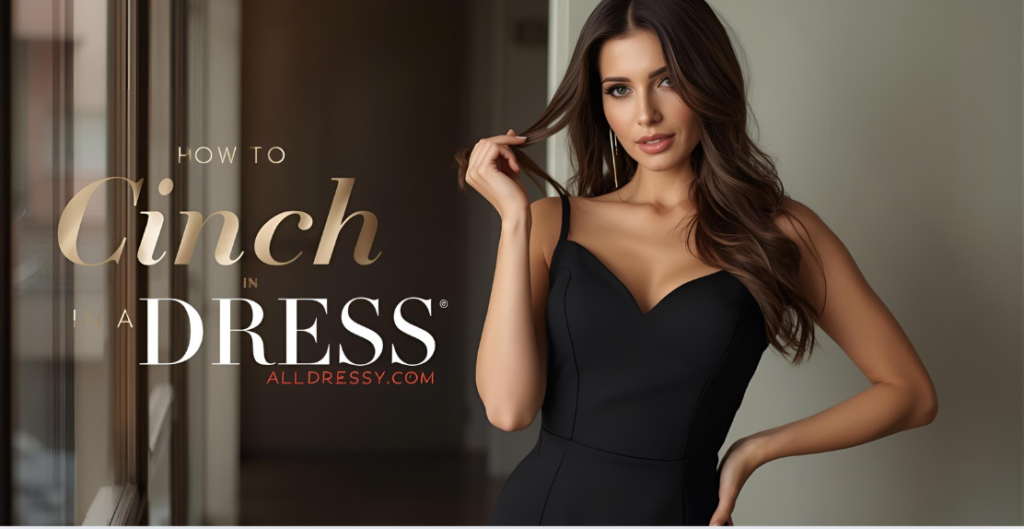The transformative power of a beautifully defined waist is one of fashion’s best-kept secrets. It’s the difference between a dress that simply hangs and a dress that sculpts, flatters, and exudes confidence. Whether you’re preparing for a special event, refreshing your daily style, or working with a garment that’s a little too forgiving in the midsection, knowing how to cinch in a dress is an essential skill. This process is about more than just making a dress smaller; it’s about mastering the art of creating a balanced, hourglass-inspired silhouette that highlights your natural shape. The quest to understand how to cinch in a dress can lead you down two parallel paths: temporary styling tricks for instant results and permanent alterations for a custom-fit wardrobe.
Many people feel limited by dresses that don’t acknowledge their waist, often making them feel boxy or shapeless. This guide is designed to be the most comprehensive resource available, demystifying the entire process. We will explore a wide range of techniques, from the simple use of accessories to the intricacies of tailoring, ensuring you have the knowledge to tackle any dress in your closet. Learning how to cinch in a dress effectively empowers you to take control of your style, adapt off-the-rack clothing to your unique body, and always present your most polished self. Let’s begin by exploring the most accessible and immediate methods: using belts and accessories.
The Art of the Accent: Using Belts to Cinch Your Waist

The belt is the most straightforward and versatile tool in your arsenal when learning how to cinch in a dress. It’s an instant solution that can dramatically alter the look and feel of an outfit.
Choosing the Perfect Cinching Belt
Not all belts are created equal. The right choice depends on the dress’s fabric, neckline, and style.
- The Wide Cincher Belt (2-4 inches): This is your go-to for creating a powerful, dramatic waist definition. Wide belts are incredibly effective at gathering excess fabric and creating a strong horizontal line that visually contrasts with the bust and hips, enhancing the hourglass effect. They work best on structured fabrics like denim, ponte knit, or thick cotton, and are ideal for fit-and-flare, shirtwaist, or A-line dresses.
- The Slim Leather Belt (½ – 1 inch): A classic thin belt is perfect for more delicate dresses or those made from softer, drapey fabrics like silk, satin, or jersey. It provides definition without overwhelming the garment. This style is excellent for sheath dresses, wrap dresses, and maxi dresses where you want a subtle hint of shape.
- The Elasticated or Corset Belt: For a truly dramatic, vintage-inspired look, a corset belt or one with elasticated lacing can cinch in a dress like nothing else. These are statement pieces best suited for solid-coloured, simple dresses where the belt can be the star.
- The Chain Belt: A modern alternative, a chain belt adds definition with a touch of glamour. Its slightly flexible nature allows it to conform to your waist, making it great for both casual and evening wear.
Strategic Placement is Key
Where you place the belt is as important as the belt itself.
- Your Natural Waist: This is the smallest part of your torso, typically just above your navel and in line with the bottom of your ribcage. Placing a belt here is almost always the most flattering option, as it creates a balanced proportion between your upper and lower body.
- The Empire Waist: For a more romantic, flowy look, place a thin belt directly under your bust. This works wonderfully with empire-line dresses, babydoll styles, or dresses with a high waist seam, creating a long, leggy silhouette.
- The Low-Slung Hip Belt: This is a very specific, casual look where a belt is placed on the hips over a loose-fitting dress or tunic. It provides a relaxed shape rather than a sharp cinch.
Beyond the Belt: Creative No-Sew Methods to Cinch a Dress
What if you don’t have a belt, or the dress style doesn’t accommodate one? Several ingenious no-sew techniques can help you achieve a custom fit.

The Safety Pin Method: A Tailor’s Secret
This is a discreet and highly effective temporary alteration for dresses with a back zipper.
- Put on the dress and zip it up as far as is comfortable.
- Pinch the excess fabric on either side of the zipper at your waistline.
- Using a large, sturdy safety pin, secure the folded fabric from the inside of the dress. Pin through both the dress fabric and the lining if it exists, parallel to the zipper.
- The result is an invisible tuck that pulls the dress in at the waist without affecting the front appearance. For more significant excess, you may create two small pleats on either side of the zipper and secure them with safety pins.
The Rubber Band & Wrap Trick
This method is perfect for creating a bloused or ruched effect on a loose-fitting dress, especially when you want to wear a cardigan or jacket over it.
- Gather the back of the dress at your waistline and twist a large, thick rubber band around the bunched fabric to secure it.
- This will create a temporary “bubble” of excess fabric at the back.
- Conceal the bunching by wearing a stylish jacket, blazer, or a long, draped cardigan over the dress. This gives the illusion of a fitted dress underneath.
Layering for Structure
Sometimes, the secret to a cinched waist lies in what you wear underneath.
- Shapewear: High-quality shapewear is designed to smooth and sculpt your silhouette. A waist-cinching bodysuit or high-waisted shorts can provide a seamless foundation that makes any dress fit more closely to your body’s contours.
- A Structured Slip: Wearing a slip with built-in boning or light structuring can add shape to a flimsy dress, giving it a more defined form from the inside out.
The Permanent Solution: How to Cinch a Dress with Sewing Alterations
For a flawless, permanent fit, sewing alterations are the gold standard. These methods require more skill but deliver a professional, built-in cinched waist.
Taking in the Side Seams: The Most Common Alteration
This is the standard method tailors use to make a dress smaller through the torso.
- Turn the dress inside out and put it on.
- Have a helper pin the side seams, taking in an equal amount of fabric on both sides. The new seam should follow the curve of your waist.
- Carefully take the dress off without disturbing the pins.
- Using a sewing machine, stitch along the new pinned seam line, starting from under the arm down to the hip.
- Try the dress on right-side out to check the fit before trimming the excess seam allowance and finishing the raw edges with a zigzag stitch or serger.
Adding Darts for Precision
Darts are small, stitched folds that remove excess fabric in specific areas, providing three-dimensional shape. They are essential for how to cinch in a dress that is baggy in the bust or lower back.
- Front Darts: Typically found on either side of the bust, pointing towards the apex. They help define the waist under the bust.
- Back Darts: Vertical darts on the back of a dress, running from the shoulder blades down to the waist or from the waist up, which eliminate back gaping and create a closer fit.
Installing an Elasticated Back
This is a fantastic alteration for sheaths or shift dresses, adding comfort and shape.
- Create a vertical opening in the centre back of the dress, if one doesn’t exist.
- Attach a panel of wide elastic to the inside of the dress, between the back seams at the waist level.
- When the dress is fastened, the elastic pulls the back in, creating a cinched effect while allowing for movement. This is often seen in bridesmaid dresses and formal wear.
The Power of Illusion: Styling Tricks to Create a Cinched Waist
Sometimes, the most powerful way to cinch in a dress is to create the illusion of a waist through strategic styling and colour choices.
The Magic of Colour Blocking
Wearing a dress with contrasting colours or patterns that meet at the waist can visually create the definition you’re seeking. A dress with a dark centre panel and lighter sides, or a print that gathers at the waist, naturally draws the eye inward.
Strategic Necklines and Hemlines
- V-Necks and Sweetheart Necklines: These necklines create a vertical or curved line that draws the eye downward, towards the centre of your body, subtly emphasizing the waist.
- A-Line and Fit-and-Flare Skirts: A dress that is fitted through the bodice and then flares out at the waist automatically makes the waist appear smaller by contrast. This is a classic, foolproof silhouette.
The Right Foundation Garments
As mentioned with shapewear, the right undergarments are crucial. A well-fitted bra that lifts and separates can dramatically improve your posture and the way a dress hangs from your shoulders, making it easier to define your waist.
Frequently Asked Questions: How to Cinch in a Dress
What is the easiest way to cinch a dress without a belt?
The easiest no-belt method is the safety pin technique at the back. It requires only a safety pin and takes seconds to execute, providing an immediate and discreet improvement in fit by taking in excess fabric around the zipper.
Can you cinch a dress that is too big all over?
Yes, but it requires more extensive work. If the dress is too big in the bust, waist, and hips, the best permanent solution is to take in the side seams along the entire length of the dress. For a temporary fix, a very wide belt can gather a significant amount of fabric at the waist, but the fit through the bust and hips will still be loose.
How do you cinch a backless dress?
A backless dress presents a unique challenge as you cannot use a standard belt or alter the back. Your best options are:
- Choose a dress with a built-in tie or sash that can be fastened at the front or side.
- Use strategic draping with a stylish shawl or scarf, wrapping it around your waist and tying it in a way that defines your shape.
- Consider internal alterations like taking in the side seams to ensure the fit is as snug as possible without needing back support.
What type of belt is best for cinching a bulky sweater dress?
A wide (3-4 inch), structured leather or faux leather belt is ideal for a sweater dress. The width and rigidity are needed to compress and define the chunky knit fabric. A thin belt will simply get lost and be ineffective.
Is it possible to cinch a dress that has no defined waistline?
Absolutely. The key is to create the waistline. Use a bold, contrasting belt to establish a visual waist. You can also create shape by layering a structured jacket or cropped blazer over the dress, which, when left open, will frame the centre of your body and suggest a narrower waist.
Conclusion: Embrace Your Shape with Confidence
Mastering the various methods of how to cinch in a dress is a transformative skill that unlocks the full potential of your wardrobe. It’s a journey that ranges from the instant gratification of belting a shift dress to the satisfying permanence of a sewing alteration. This knowledge empowers you to no longer be passive about your clothing but to become an active participant in shaping your style. You can now rescue ill-fitting sale items, reinvent old favourites, and wear any dress with the confidence that comes from a perfect, flattering fit.
Remember, the goal is not to conform to a specific standard of beauty but to highlight your unique shape and feel empowered in your clothing. Whether you achieve it with a clever accessory, a hidden safety pin, or the skilled hand of a tailor, a cinched waist is more than just a style detail—it’s a statement of self-assurance. So, open your closet, experiment with these techniques, and discover the joy of a silhouette that makes you feel truly and authentically you.

